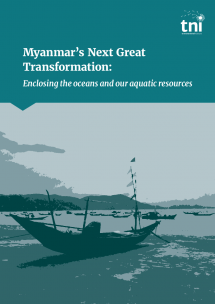Ideas into movement
Boost TNI's work
50 years. Hundreds of social struggles. Countless ideas turned into movement.
Support us as we celebrate our 50th anniversary in 2024.

Top-down conservation projects, (Eco-)tourism, large-scale aquaculture and the expansion of industrial infrastructure are transforming Myanmar. Myanmar's coastal and inland aquatic resources are vast, but these evolving processes and dynamics raise important questions about who benefits from using these resources, who gets to access them and where control lies.

Myanmar is on the front lines of a new cycle of transformation. A wide array of changes in access to and control of the country’s vast coastal and inland aquatic resources are unfolding in Myanmar today. Aquatic resources include fish, mangroves, coral reefs and other plants, the sand and the coast, oil and gas resources, the water itself, and much more. These resources play a vital role in the lives and livelihoods of Fisher peoples’ lives and livelihoods in Myanmar. These new dynamics threaten to take these resources out of the hands of villagers and the country as a whole, and place them firmly in an increasingly ubiquitous market-system.
The varied processes of enclosure currently unfolding across Myanmar raise important questions about who has access to and control over the country’s aquatic resources and who benefits from using them.
Did you enjoy this content? Then please consider supporting TNI.
Support our crucial research and help us to work on the critical issues of our time. We work at the crossroads of movements, activists, policy makers and scholars to enhance public debate and turn ideas into movement. Become a supporter now.